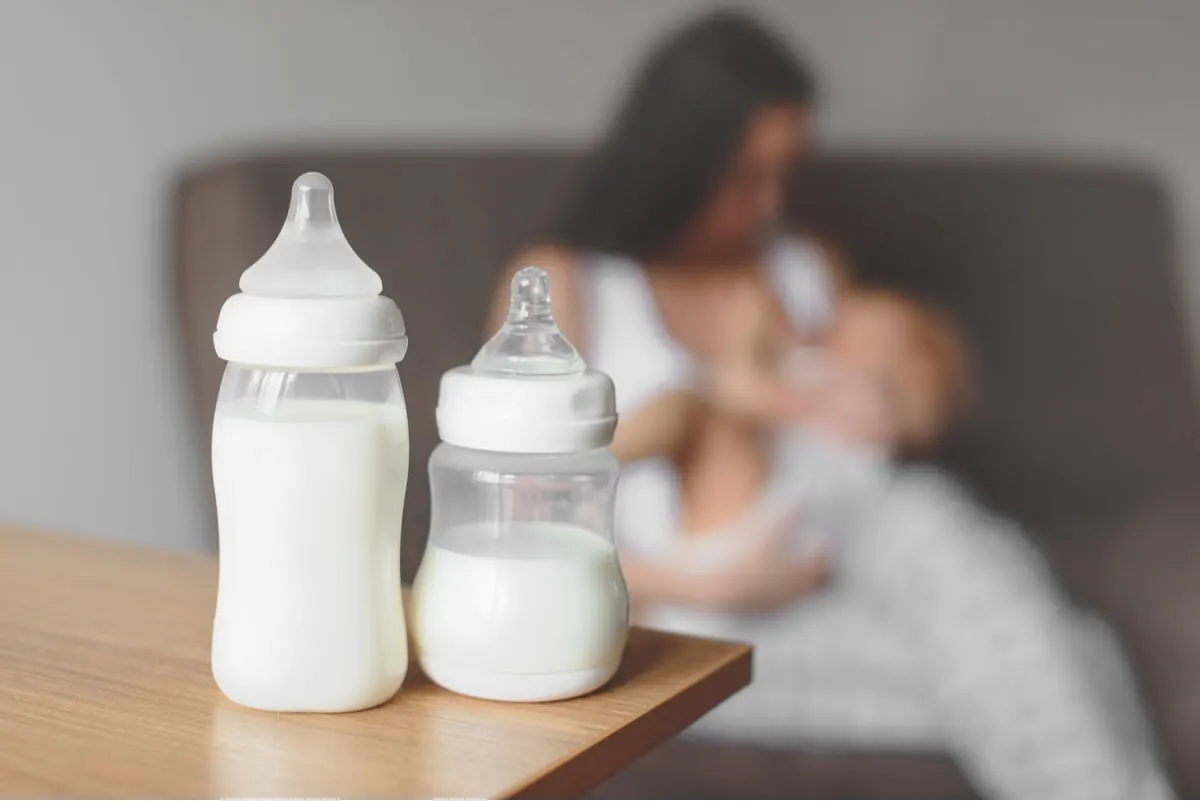Nipple Confusion Syndrome: Causes and Solutions


Reviewed and approved by the nurse Leidy Mora Molina
Nipple confusion syndrome is a condition that occurs in infants who fail to suckle properly when breastfeeding. They feel more comfortable doing so from a bottle.
Most commonly, the problem occurs in babies who have been breastfed with artificial nipples shortly after birth. This leads to the little ones feeling lost and bewildered when they drink milk from the mother’s breast.
Nipple confusion syndrome is more common in premature infants. It’s a significant problem, as it’s very important for them to drink breast milk due to all the benefits it brings to their growth and development.
What is nipple confusion syndrome?
Nipple confusion syndrome is a condition in which the baby has trouble feeding directly from the mother’s breast. Typically, this leads them to hurt the mother’s nipple. At the same time, the baby seems to prefer the bottle.
A baby with nipple confusion syndrome is restless at the breast. Some infants may reject the breast and even become uncomfortable as soon as the mother puts them in the breastfeeding position. They cry and place their hands in front of the breast.
They have difficulty starting to drink breast milk. It’s as if they can’t find a way to settle down.
They move around a lot and tug at the mother’s nipple nervously. In fact, they sometimes become aggressive when the breast is approached. They usually prefer the bottle.

Causes
It’s often thought that drinking milk from a bottle is very similar to drinking from the mother’s breast. However, they are two very different processes.
Sucking from each source requires different movements of the baby’s tongue and mouth muscles. In addition, the amount of milk obtained from the bottle is much greater than that obtained from the mother’s breast.
Hence, nipple confusion syndrome is more common in infants who receive breast milk and a bottle simultaneously. Especially if this occurs soon after birth.
What occurs in the baby is confusion. In some respects, it’s easier to suck from the bottle and this gives them more milk. So when they drink from the mother, they have to make different movements and get less milk.
Get to know: How To Store Breast Milk
Effects of nipple confusion syndrome
Nipple confusion syndrome can affect breastfeeding in many ways. As well as causing injury to the mother, it may also jeopardize the continuity of breastfeeding itself.
Grasping difficulties
The bottle has a nipple that protrudes and is easier for the baby to latch on to. The mother’s nipple may have other characteristics and it can become difficult for the baby to latch on to the breast.
Sucking difficulties
To drink breast milk, the baby must open its mouth wide to adapt to the breast. This doesn’t happen with bottles.
If the baby replicates the way it sucks from the bottle when breastfeeding, it may hurt the mother. In addition, there may be a lower milk supply, because there’s no adequate compression of the milk ducts.
Breast refusal
Sometimes, the baby’s difficulty in suckling from the breast is so great that he/she ends up rejecting this form of feeding. There are even cases in which you may get the so-called nursing strike, in which there’s a total rejection of the mother’s breast.
You might also be interested in: Uneven Breasts During Lactation: How Can They Be Corrected?
How to solve nipple confusion syndrome
When a baby has nipple confusion syndrome, the best thing to do is to reduce this confusion and withdraw the bottle. It’s best to do it gradually and give the supplementary milk in another type of container.
The goal is for the baby to relearn to drink milk from the mother’s breast and to “unlearn” feeding from the bottle. Some of the options are the following.
Syringe feeding
This is suitable for premature babies or babies who are just a few weeks old. It’s advisable to use a syringe with a good capacity and one that can be manipulated with one hand.
Just drip the milk on the baby’s tongue, without inserting the syringe.
You can also insert a finger against the baby’s palate. When the baby begins to suckle, allow the milk to slide down the finger.
Spoon or spoon container
Milk can be spoon-fed and this technique also helps to correct nipple confusion syndrome.
However, learning is often slow and it isn’t uncommon for infants to spit up milk due to a lack of coordination. However, with some patience, this can be achieved.
There are also spoon containers, which are similar to a bottle. They have a cylinder shape containing a valve and a silicone device that acts as a spoon.

Cups or glasses
A cup or glass is also a good choice. It’s best to use a small container, resting it against the child’s lower lip.
Some babies bring milk into their mouths with their tongues and others suck. Special cups and glasses are available on the market.
Breast pump
The breast pump is a container with one or two probes that connect to the mother’s nipple. Breast milk is collected in it. The mother should place it around her neck.
When the baby sucks, both the milk from the breast and the milk collected in the container come out. In this way, the baby will get enough nourishment.
Bottle feeding isn’t recommended for most babies
To avoid nipple confusion syndrome, it’s best not to give milk in a bottle if the child is able to breastfeed. Most infants don’t have any problems feeding on their mother’s breast and don’t require formula feeding.
When a baby develops nipple confusion syndrome, it may take several weeks, or even a couple of months, before the condition is reversed. Be patient.
All cited sources were thoroughly reviewed by our team to ensure their quality, reliability, currency, and validity. The bibliography of this article was considered reliable and of academic or scientific accuracy.
- Agrelo, F., Lobo, B., Chesta, M., Berra, S., & Sabulsky, J. (1999). Crecimiento de niños amamantados y alimentados con biberón hasta los 2 años de vida: estudio CLACYD, 1993-1995. Revista Panamericana de Salud Pública, 6, 44-52.
- Sánchez, L. M., González, E. D., Florensa, S. G. T., & Marti, J. G. (2000, January). Uso del chupete: beneficios y riesgos. In Anales de Pediatría (Vol. 53, No. 6, pp. 580-585). Elsevier Doyma.
- Urquizo Aréstegui, R. (2014). Lactancia materna exclusiva:¿ siempre?. Revista Peruana de Ginecología y Obstetricia, 60(2), 171-176.
- Brahm, P., & Valdés, V. (2017). Beneficios de la lactancia materna y riesgos de no amamantar. Revista chilena de pediatría, 88(1), 07-14.
This text is provided for informational purposes only and does not replace consultation with a professional. If in doubt, consult your specialist.








